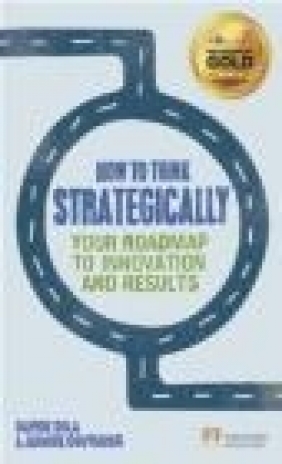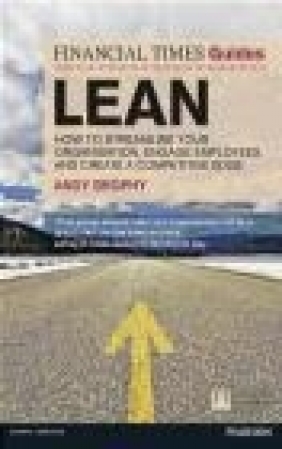FT Guide to Lean
Andy Brophy
FT Guide to Lean
Andy Brophy
- Producent: Financial Times
- Rok produkcji: 2012
- ISBN: 9780273770503
- Ilość stron: 320
- Oprawa: Miękka
Niedostępna
Opis: FT Guide to Lean - Andy Brophy
Learn how to make your company more efficient, increase customer value with less work and make better use of your organisation's resources by implementing a Lean management strategy. The Financial Times Guide to Lean is a guide to the tools that are used to implement Lean, showing you how to apply Lean practices fully into your organisation or company. This book offers a comprehensive and objective look at lean strategy and how it can be tailored for different companies.Table of Contents Acknowledgements Introduction Part I: Getting started: Lean orientation and diagnostic phase Chapter 1 Lean management What is Lean? Why Lean? Brief history of Lean Lean today True North Lean The five principles The Lean operating system First Pillar: Continuous improvement Second Pillar: Respect for People Hidden waste is robbing our profits Muda Muri Mura Chapter 2 Hoshin Kanri strategy deployment Introduction The Hoshin process 1. Reflection on the previous year's performance 1.2 Review of the organisations vision, mission, and values 1.3 Objectives for the forthcoming year 1.4 Alignment building and action plans 1.5 X-matrix development 1.6 Monthly evaluation 1.7 Annual evaluation Review Chapter 3 Value stream mapping Introduction What flows in value stream maps? Value stream mapping categories Value stream mapping stages 1. Team formation 2. Draw the current state value stream map 3. Create the ideal state value stream map 4. Develop the future state value stream map 5. Develop the improvement plan Case Study: Outpatients orthopaedic clinic Global background Outpatient's clinic overview Current state value stream map baseline discussion Clinic ideal state value stream map discussion Clinic future state value stream map discussion Box score discussion Review Part II: Lean transformation practices Chapter 4 Lean methods and tools (part I) Section 1: 5S workplace organisation Introduction Waste (symptom) and 5S countermeasure How to apply 5S workplace organisation Sort Set-in-Order Shine Standardise Sustain 5S review Section 2: Visual management Why use visual management Levels of visual management Visual management centre (VMC) Operational tracking at the gemba Visual management review Chapter 5 Lean methods and tools (part II) Section 1: A3 problem solving Introduction Why A3 A3 document 1. Cause and effect diagram 2. Pareto chart 3. Process map 4. Tally sheet 5. Scatter plot 6. Run chart 7. Histogram Types of A3 Categories of problems A3 review Section 2: Standard work Introduction Standard work and job classifications Improving standard work Bringing standard work to life Job breakdown sheet Standard work review Chapter 6 Lean methods and tools (part III) Section1: Idea management system Introduction Documenting ideas is crucial Idea metrics Reward and recognition Idea process flow Idea management system review Section 2: Kaizen events Introduction Kaizen stages Pre-event preparation Event workshop Confirmation phase Kaizen review Chapter 7 Lean methods and tools (part IV) Section 1: Quick changeover Introduction Why quick changeover SMED methodology Quick changeover review Section 2: Total productive maintenance Introduction Why TPM? Application of TPM TPM improvement plan TPM review Chapter 8 Lean methods and tools (part V) Section 1: Kanban Introduction Why kanban Types of kanban Kanban sizing calculation example Culture and people implications Kanban rules Supplier kanban in a hospital setting Kanban in a hospital setting Kanban review Section 2: Poke yoke Introduction Mistake proofing classifications Mistake proofing routine Poke yoke review Chapter 9 Lean methods and tools (part VI) Flow practices Introduction River and rocks analogy Batch size implications for flow A word on inventory The problem with traditional production scheduling using Materials Requirement Planning (MRP) Preconditions for flow Family identification Map the value stream Identify bottlenecks and variation Cellular flow Human implications for flow Flow practices review Part III: Leading the Lean transformation Chapter 10 Developing the Lean culture Introduction Cathedral model Model foundation Accountability process Set expectations Recognition True coaching and delegation Double diamond coaching model Constructive feedback Escalation Quantity and quality Review Acknowledgement Chapter 11 The technical side of sustaining Lean Introduction Systems thinking Hoshin Kanri strategy deployment Leadership Sustaining Lean through problem solving Lean daily management system Training within industry (TWI) Metrics Review Chapter 12 The people side of sustaining Lean Introduction Leadership Engaging people in Lean Oh, if only we had the luxury of time for improvement work! Communication Middle management A propensity for risk taking A rising tide should lift all boats Review Chapter 13 Putting it all together: The Lean Roadmap to Transformation Introduction Generic roadmap 1. Understand value through the eyes of your customers 2. Articulate the business case for transformation 3. Lean assessment 4. Value stream mapping 5. Build leadership commitment and set expectations 6. Hoshin Kanri strategy deployment 7. Management of change plan 8. Pilot Lean model area and spread plan 9. Build the Lean knowledge 10. Lean culture 11. Sustaining Lean 12. Hansei Review References and further reading Glossary Appendix Index
Szczegóły: FT Guide to Lean - Andy Brophy
Tytuł: FT Guide to Lean
Autor: Andy Brophy
Producent: Financial Times
ISBN: 9780273770503
Rok produkcji: 2012
Ilość stron: 320
Oprawa: Miękka
Waga: 0.61 kg































